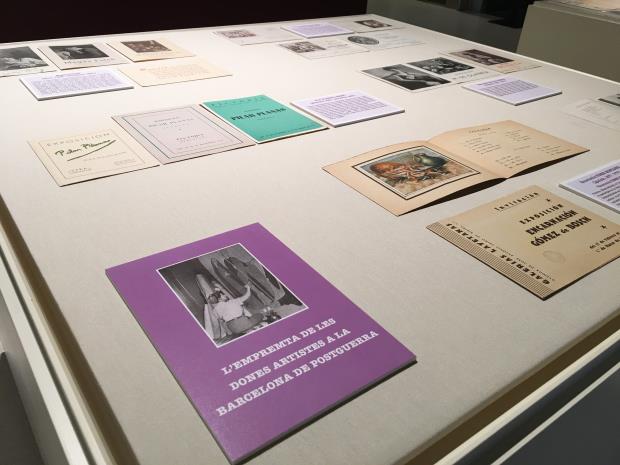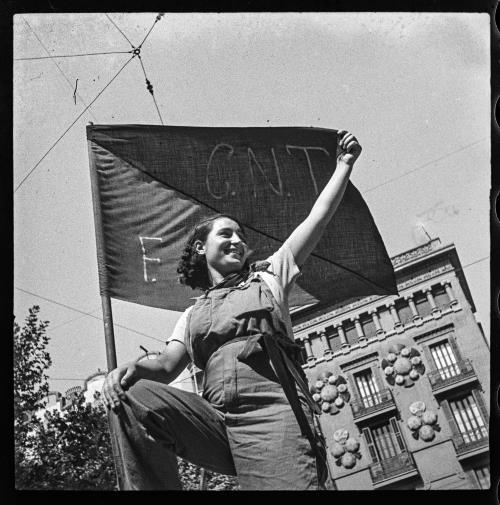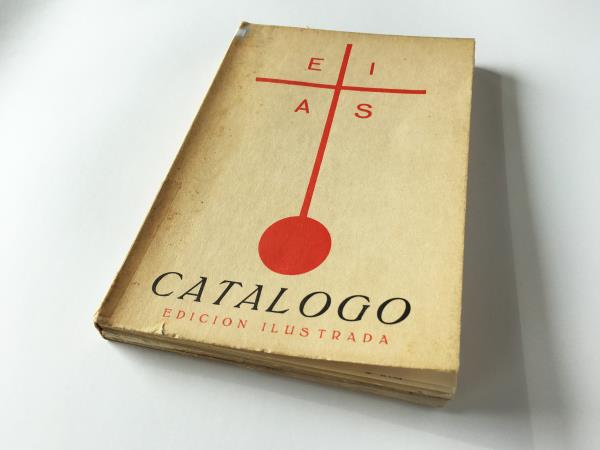Sandra Herrera and Yolanda Ruiz

The Joaquim Folch i Torres Library, continuing its commitment to make the work of women artists visible, has paid tribute to those who exhibited in the art galleries of the city of Barcelona during the post-war period (1939-1952 ). To do so, a set of materials from the small catalogues section of the library has been selected and on the one hand, a virtual exhibition has been designed, and on the other hand, an exhibition has been set up in the display cabinets in the foyer of the library.
Therefore, this activity is in line with one of the axes that the Museum will be working on during the exhibition projects of 2021, the Spanish Civil War.

The information files of the galleries: a valuable source of information
Firstly, carrying out the selection of the material required a primary source of information that provided specific data about the artists, the galleries where they exhibited, and the dates of those exhibitions. The library has a collection unknown to many people, which provides the data needed to trace the presence of women artists in Barcelona’s galleries during the post-war period.
The material we are referring to is the handwritten files of art galleries. Throughout the 20th century, the staff of the Joaquim Folch i Torres Library dedicated themselves to documenting the exhibitions held in Barcelona in these files, thanks to brochures, cards, invitations, etc. that arrived in the centre. The files are preserved in alphabetical order, according to the name of the gallery, and contain a chronological list of the exhibitions that took place there.
Handwritten files from the art galleries that are conserved in the library
Secondly, the whole period 1939-1952 was reviewed in order to identify the exhibitions carried out by women. The search began by reviewing, one by one, the more than two hundred and fifty files covering this period. Thus, a total of one hundred and forty-one exhibitions held of fifty-six women artists were detected in the various galleries active during the post-war period in Barcelona.
Then, the process of searching for information began with the aim of completing the profile of each of the artists. The reference works consulted belonging to the library collection were the Ràfols Dictionary of Contemporary artists of Catalonia and the Balearic Islands, the work Women and art in Spain: dictionary of artists prior to 1936 and the Dictionary of 20th century Spanish painters and sculptors.
Covers of the Ràfols dictionary of artists of Catalonia and the Balearic Islands, Women and art in Spain: dictionary of artists prior to 1936 and Dictionary of 20th century Spanish painters and sculptors.
Finally, a selection of artists was made that would form part of the virtual exhibition and the physical exhibition in the display cabinets. In the case of the virtual exhibition, the list of women was reduced to twenty-seven, as many were either not included in any source of information consulted or the information available was very limited and it was impossible to document it in a minimal way. In the case of the display cases in the foyer, due to space limitations, sixteen artists were chosen who reflected the variety of post-war artistic trends.


Setting up the exhibition
Section of small exhibition catalogues
The selection of the material that was to be part of the two exhibitions was carried out in the section of small exhibition catalogues. This section, made up of more than 2,300 archive boxes, contains, above all, very important material for research on artistic activity in Barcelona, but also in Spain and internationally. This collection consists of publications produced on the occasion of the exhibitions (invitation cards, hand catalogues, exhibition brochures, etc.).


Section of small catalogues of the library and selection of a sample of small catalogues
The post-war women artists
Once the war ended, Spain began a period in which it lived in isolation, closed in on itself. Censorship was exercised over anything that did not conform to the issues promoted by Franco’s Regime. Because of this, many artists were forced into exile from the country and those who remained had to detach themselves from full creative freedom.
Furthermore, the predominance of an archaic female model under male domination meant that women had no place in the work and public spheres, being restricted to the private and domestic space. The field of the arts was no exception.
In Barcelona, meanwhile, there was a strong artistic movement that was reflected in intense activity by art galleries. As an example, between 1939 and 1944, a total of 1,469 exhibitions were held in the city, distributed among some thirty art establishments. The presence of women artists in these exhibitions was approximately 10% of the total, a fact which reflects the situation of silencing the female voice in public and artistic life.
Collective exhibitions in the post-war period
Even so, some upper-class women, related to the principles of the Women’s Section or linked to men closely related to Franco’s Regime, participated in exhibitions at a Spanish level. An example of this was the International Exhibition of Sacred Art held in Vitòria in 1939. Some of the women artists who participated included Mercè Llimona, Julia Minguillón, Marisa Roesset, Margarita Sans Jordi or Rosario de Velasco.


The National Exhibition of Fine Arts also counted on the participation of women artists such as Joaquima Costa i Pujol, Milagros Daza, Montserrat Fargas, Consuelo Matoses, Nieves Ortiz Comellas, Marisa Roesset, Conchita Salinero Forcada or Rosario de Velasco herself.
This event had been held in Spain since 1856 and resumed in 1941, after the parenthesis caused by the outbreak of war. The artists participating in the national exhibitions were obliged to adapt to the required characteristics in terms of style, form, materials and theme of the works. Moreover, a document proving their adherence to the Regime was also required.
The Academia Breve de Crítica de Arte (The Brief Academy of Art Criticism) designed to promote cultural and artistic activity, organised the Salón de los Once; an annual exhibition in which eleven artists exhibited. These exhibitions counted on the participation of María Blanchard, Olga Sacharoff and Rosario de Velasco.
Aesthetic trends
The women artists did not break free from the dominant ideology and assumed the values and role that were imposed on them. The theme of their works was not at all groundbreaking and they cultivated with realism the themes which were tolerated by the Regime. The art critics of the time habitually highlighted the feminine delicacy of their works, repeating the clichés and conventionalisms ascribed to women artists.
Avant-garde demonstrations disappeared in the face of an extraordinary religious fervour. In such a way that the themes that inspired the women artists were in line with what was foreseen, and with a predominance of academicism. During this period a certain impressionist influence could also be seen.


Examples of religious works by women artists and examples of landscape works by women artists


Examples of flower paintings and still lifes by women artists and examples of portraits by women artists
The library gives support to research about women artists
Finally, we want to make it clear that, with all the previous research work involved in the exhibition, we have just put the finishing touches to the task of making women artists more visible. Likewise, the Joaquim Folch i Torres Library wants to make it known that it makes the material it keeps in its collection available to anyone who wants to carry out research on this subject. The library will continue to work on activities which, like this exhibition, shed light on a hidden reality.
We therefore invite you to visit the exhibition, until 31st May, in the display cabinets of the library, and in a permanent way, the virtual exhibition in the website of the museum.
Related links
The imprint of women artists in post-war Barcelona
Biblioteca Joaquim Folch i Torres












